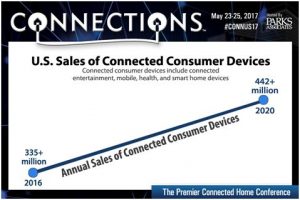
Connected consumer devices to soar by year 2020
Stephen Law
Automation / Robotics Electronics Wireless Engineering IoT consumer electronicsAnalysts and industry leaders examine smart home and connected entertainment markets
More than 442-million connected consumer devices will be sold in the U.S. in 2020, according to comprehensive IoT forecasts and data presented by Parks Associates analysts.
These sales totals include connected entertainment, mobile, health and smart home devices. Personal assistant devices, which include speakers with voice control such as the Amazon Alexa and Google Home, are the fastest growing category with a CAGR of 78.3% in 2015-2020. The firm further examines the role of voice in the IoT in its recently released whitepaper.
Parks Associates released this info during its 21st-annual CONNECTIONS Conference taking place at the Hyatt Regency San Francisco Airport this week. The event features analyst presentations on new consumer research and panel discussions with high-level executives from start-ups, Fortune 500, venture capitalist, public relations and media companies.
“Parks Associates research shows U.S. consumers will buy more than 2.3 billion connected devices between 2015 and 2020 and they are showing strong preferences for voice as the interface for their devices,” says Elizabeth Parks, SVP, Parks Associates. “Companies in the smart home, entertainment, and connected car ecosystems are pursuing partnerships that can add voice control to a variety of solutions in the connected home.”
“We’ve only scratched the surface of what the connected home can do for consumers and companies,” adds William Greene, product manager, energy services, Nest Labs. “At Nest, we’ve learned that combining connected devices with simple – yet sophisticated – software can meet the connected consumer’s expectations for reliability and convenience while opening new opportunities for engagement. In addition to creating happier and more loyal customers, this enhanced engagement can benefit companies and precipitate revolutionary changes in verticals like energy utilities. Every connected consumer represents an opportunity for huge advancements in engagement strategy, operational efficiency, and the realization of shared benefits across industries and regions.”
“Wi-Fi is by far the dominant technology for connected products – the vast majority of broadband homes have Wi-Fi. However, historically it has been too complex to get headless products connected to Wi-Fi,” says Rob Conant, CEO, Cirrent. “Nearly 40% of the negative reviews of smart home products are the result of connectivity and setup issues. Making it easy for end users to connect products is critical to the success of the industry.”
“As consumer awareness of the connected home grows we will discuss how companies move further into the mainstream by delivering valuable solutions that solve real-world problems in ways that are tangible to homeowners,” notes Scott Harkins, VP IoT partner programs Honeywell Connected Home & Buildings, Honeywell.

